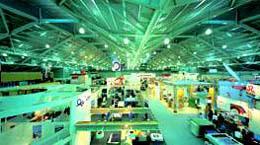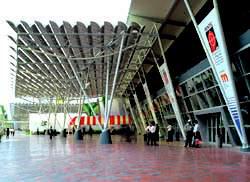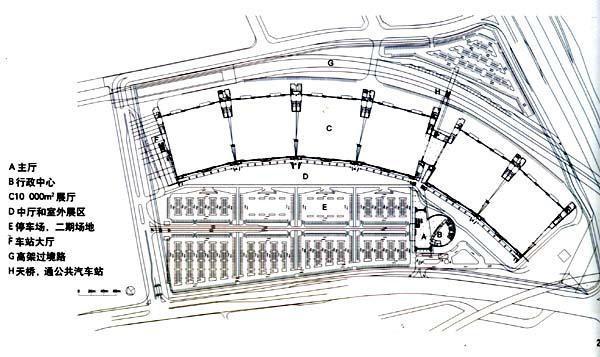新加坡展览中心
2001-07-10
新加坡展览中心,是考克斯瑞纳建筑师事务所设计的第四个大型展览中心。
场地是靠近长基(changi)机场的沼泽地,高速过境走廊在此形成连续弧线。设计中,沿弧线布置6个展厅,各10 000m2,设计力图做到技术与舒适的统一,安排突出一个开放空间,其入口很象传统的公园。
第一它使人们能够从任何地点体会中心的规模和体量,直线或重叠布置,就做不到这一点。第二,公园面积加大,可作为室外展览空间,每个展厅都有相同入口。第三,服务车辆靠近快速路,不用进入场地中心。最后,弧形平面产生的半径和环形,利于空间的开发。
中心花园长600m,宽100m,它即作为室外展区,又作为室外广场。中央主厅位于弧线的垂直轴线上,面对主路。中央主厅的旁边是会议中心,鼓形造型显示它是建筑的集散点。主厅连接各展厅,直通汽车站。
在中心的远端,是过境旅客集散点。该车站也是一个鼓形建筑,显示它是建筑的另一个集散点。主厅通过地面层和夹层,贯穿整个建筑。展览人员可从夹层俯视展厅或观赏花园。
每个展厅的屋顶,都由3个拱形三角屋架构成,它们有助于排烟,并形成高大空间。此结构跨度并不是最大,但却保证60 000m2无障碍空间。每个展厅的屋顶,都可在地面组装,8h内即可吊装到位。
弧形平面为第二阶段40000m2展厅留出充分空间。此空间暂时用作停车场。将来停车场将建在地下,上面为展厅,花园被围合形成中厅。二期完工后,两边的展厅均可举办永久性展览,比现在线性布置更灵活。
新加坡展览中心,也是合作的产物。它由澳大利亚建筑师设计,韩国现代公司施工,大部分在中国加工,最后在新加坡安装。文化与地理之间的差异,得到很好克服。优秀设计,不仅是建筑师的杰作,也是所有参与人员的工作成果。
历史上大的展览中心,都是为临时展览而建,都已过时。新加坡展览中心保持了展览建筑的传统,它不是一味追求技术。创造了一种节日气氛。它不是孤立的展室,而是民众活动的中心。(刘河译)
Singapore Expo is the fourth major exhibition centre by Cox Rayner Architects, others being in Brisbane, Sydney and Cairns Australia. It was awarded through a design competition that included Rem Koolhaas, Weidelplan and Nikkon Sekkei. Our approach endeavours to form a balance of technology and delight. Although Paxton had Hyde Park as an ideal setting and our Sydney and Brisbane centres are sited within gardens and parkland, the Expo site is mainly swampland near Changi Airport. Its main geometric feature is the Mass Rapid Transit corridor (built concurrently) which forms a continuous arc around the site. The centre‘s planning follows this curve and comprises 6 halls of 10,000m2, each linearly connected around the arc. The purpose of this arrangement is to centralise an open space and so recreate the tradition of the parkland frontage.A number of social and physical advantages evolved from this pattern. The curvature enables people to comprehend the scale and extent of the centre from any standpoint, which would have been impossible in a straight line or layered format. Secondly, the gardens double as external exhibition area to which every hall has equal access. Thirdly, service vehicles are kept adjacent to the MRT corridor, keeping them out of the heart of the site. Lastly, the curved plan produced a geometry of radii and annuli from which interesting spaces could be developed.The focal space is the central garden that are covered by a bris soleil approximately 600 metres long and 100 metres wide in the centre, tapering toward the edges. This space is both external exhibition area and external foyer. The main internal foyer is created by a perpendicular axis emerging like a ‘crank‘ arm from the general curvature and addressing the main street frontage to the site. Offset beside the foyer is the convention centre, its drum shape acting as a fulcrum and signifying the address point to the building. The foyer continues through the exhibition halls to the far side where the bus terminus is located as a separate address point designed to avoid congestion.At the far end of the centre is a further address point for transit passengers, connected to an MRT station designed by Sir Norman Foster. The station is a second drum shape which by design or coincidence provides clarity for the two main addresses. The foyers are connected along the length of the building by ground and mezzanine concourses, the latter designed primarily for exhibitors to overlook the halls but also affording elevated views of the gardens.The roof structure of each hall comprises three arched and triangulated trusses which form articulated ribs facilitating smoke extraction and high exhibition volumes. Although not the largest span for an exhibition building (even Ferdinand Dutert‘s 1889 Galerie des Machines spanned 114 metres), this structure produces 60,000 square metres of uninterrupted floor space. It was configured so as to allow each hall roof to be raised in one piece over an 8 hour period from its assemblage on the floor slab.
 展厅内景 |  中央主厅 | |
 带雨棚入口外观 |  外景 |

雨棚大样

总平面图
